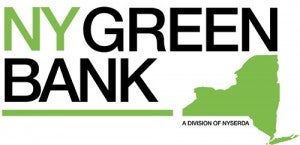EDF Co-Hosts International Green Bank Summit on Catalyzing Private Sector Capital for Clean Energy
 In order to fund the transition to a low-carbon economy at a pace rapid enough to prevent runaway climate change, the International Energy Authority has estimated that an annual $1 trillion will be required globally. What policies or mechanisms can be used to facilitate private capital engagement on so grand a scale?: Green banks, which are government-created financial institutions that use attractive interest rates and other incentives to leverage money from the private sector to fund clean energy projects.
In order to fund the transition to a low-carbon economy at a pace rapid enough to prevent runaway climate change, the International Energy Authority has estimated that an annual $1 trillion will be required globally. What policies or mechanisms can be used to facilitate private capital engagement on so grand a scale?: Green banks, which are government-created financial institutions that use attractive interest rates and other incentives to leverage money from the private sector to fund clean energy projects.
Earlier this week, EDF co-hosted the first day of the two-day, second annual International Green Bank Summit in our New York City headquarters, bringing together green bank stakeholders from around the world. The summit focused on how green banks can better leverage limited amounts of public capital to engage and accelerate the deployment of private capital into essential energy efficiency, renewable energy, and climate change mitigation initiatives.
Green banks are catalysts
With one dollar of public finance leveraging about three dollars of private capital, global green banks have catalyzed nearly $20 billion dollars to date in clean energy projects around the world and expect to raise more than $40 billion over the next five years. So far, only a handful of countries have developed green banks.
In the United States, several attempts to establish a federal green bank have failed, leaving states such as Connecticut, New York, Hawaii, and New Jersey to take the lead. The ultimate success of these sub-national entities will be significantly enhanced if they work in concert across geographical boundaries and pursue the same best practices. Events such as the International Green Bank Summit promote this dialogue, giving global thought leaders the opportunity to compare notes and support collective efforts.
One challenge for green banks is showing the private sector that they serve to facilitate, enhance, and accelerate private capital flows into the clean energy market – a market in which the private sector is currently not engaged at the necessary scale. To do this, they must have a keen focus on additionality, or the notion that private capital market engagement would not have occurred without the parallel engagement or intervention of a green bank.
Green banks are not in the business of concessionary lending, providing grants, or taking on risk that the private markets are not prepared to assume. Rather, they aim to bridge the financing gap that exists due to market barriers. By leveraging their limited pool of public capital to reduce risk in very clear and defined market investment opportunities, green banks support private capital engagement in profitable energy efficiency and renewable energy projects.[Tweet “EDF and @NYSERDA convened international leaders to talk green banks, the future of clean energy finance http://ow.ly/ECpgC “]
International Green Bank Summit
Hosted by the NY Green Bank, a division of the New York State Energy Research and Development Authority, the summit attracted participants from the Connecticut Green Bank, the New Jersey Energy Resilience Bank, and the Hawaii GEMS program, in addition to representatives from Japan, Australia, Malaysia, and the United Kingdom. The event welcomed leaders from green banks that recently opened to those that have been in operation for several years, as well as individuals and groups who are exploring the possibility of setting up a green bank and working diligently toward that end.
Richard Kauffman, Chairman of Energy and Finance for the State of New York, kicked off the conversation with a powerful message that the time to act on climate change is now, setting an inspirational tone for the leaders in attendance. From there, the summit provided green bank representatives the opportunity to share ideas and best practices, learn from one another, and discuss strategies for a coordinated effort to catalyze the clean energy financing markets.
Although green banks operate in markedly different social, political, and commercial contexts, discussion focused on how developing a standardized approach is critical to scaling green bank efforts. My colleague, Rory Christian, Director, New York Clean Energy, described EDF’s own Investor Confidence Project, which standardizes the development of energy efficiency projects, “something we at EDF believe is a key part of pushing toward a clean energy future.”
Going forward, we can expect greater coordinated communication between global and regional green banks to maximize their effectiveness.
The need for private capital engagement
Essential to raising substantial amounts of private capital to address the climate change imperative are new market finance tools like:
- entities (such as green banks),
- creative finance mechanisms (being developed and deployed by green banks), and
- asset classes (such as green and climate bonds)that can engage new classes of investors.
Green banks serve to incentivize and jumpstart broader private capital market engagement for clean energy projects. Ideally, we will reach the point at which the private sector can step in and take the lead in realizing the full potential of the dynamic and profitable clean energy market. But we aren’t there yet, and events such as the International Green Bank Summit play a key role in helping us get there.
Andy Darrell, my colleague and EDF’s Chief of Strategy, US Climate and Energy, summed it up nicely when he concluded, “Prosperity and environmental protection go together; it is important to make markets work well on behalf of the environmental outcomes we try to accomplish.”











